Introduction to drawing in Compose
全面了解如何在 Compose 中绘制自定义内容。
1. Introduction to drawing in Compose
当内置组件不能完全满足应用需求时,自定义绘图很有用。
drawBehind
drawBehind 允许我们在 Composables 内容后面绘制内容。例如:
kotlin
Spacer(
modifier = Modifier
.fillMaxSize()
.drawBehind({
// this = DrawScope
drawCircle(Color.Magenta)
})
)
kotlin
@Composable
@NonRestartableComposable
fun Spacer(modifier: Modifier) {
Layout(measurePolicy = SpacerMeasurePolicy, modifier = modifier)
}2. What is DrawScope?

DrawScope 接口部分源码:
kotlin
@DrawScopeMarker
@JvmDefaultWithCompatibility
interface DrawScope : Density {
val drawContext: DrawContext
val center: Offset
get() = drawContext.size.center
val size: Size
get() = drawContext.size
val layoutDirection: LayoutDirection
fun drawLine(
brush: Brush,
start: Offset,
end: Offset,
strokeWidth: Float = Stroke.HairlineWidth,
cap: StrokeCap = Stroke.DefaultCap,
pathEffect: PathEffect? = null,
@FloatRange(from = 0.0, to = 1.0) alpha: Float = 1.0f,
colorFilter: ColorFilter? = null,
blendMode: BlendMode = DefaultBlendMode
)
fun drawRect(
brush: Brush,
topLeft: Offset = Offset.Zero,
size: Size = this.size.offsetSize(topLeft),
@FloatRange(from = 0.0, to = 1.0) alpha: Float = 1.0f,
style: DrawStyle = Fill,
colorFilter: ColorFilter? = null,
blendMode: BlendMode = DefaultBlendMode
)
fun drawImage(
image: ImageBitmap,
topLeft: Offset = Offset.Zero,
@FloatRange(from = 0.0, to = 1.0) alpha: Float = 1.0f,
style: DrawStyle = Fill,
colorFilter: ColorFilter? = null,
blendMode: BlendMode = DefaultBlendMode
)
@Deprecated(
"Prefer usage of drawImage that consumes an optional FilterQuality parameter",
level = DeprecationLevel.HIDDEN,
replaceWith = ReplaceWith(
"drawImage(image, srcOffset, srcSize, dstOffset, dstSize, alpha, style, " +
"colorFilter, blendMode, FilterQuality.Low)",
"androidx.compose.ui.graphics.drawscope",
"androidx.compose.ui.graphics.FilterQuality"
)
) // Binary API compatibility.
fun drawImage(
image: ImageBitmap,
srcOffset: IntOffset = IntOffset.Zero,
srcSize: IntSize = IntSize(image.width, image.height),
dstOffset: IntOffset = IntOffset.Zero,
dstSize: IntSize = srcSize,
@FloatRange(from = 0.0, to = 1.0) alpha: Float = 1.0f,
style: DrawStyle = Fill,
colorFilter: ColorFilter? = null,
blendMode: BlendMode = DefaultBlendMode
)
fun drawImage(
image: ImageBitmap,
srcOffset: IntOffset = IntOffset.Zero,
srcSize: IntSize = IntSize(image.width, image.height),
dstOffset: IntOffset = IntOffset.Zero,
dstSize: IntSize = srcSize,
@FloatRange(from = 0.0, to = 1.0) alpha: Float = 1.0f,
style: DrawStyle = Fill,
colorFilter: ColorFilter? = null,
blendMode: BlendMode = DefaultBlendMode,
filterQuality: FilterQuality = DefaultFilterQuality
) {
drawImage(
image = image,
srcOffset = srcOffset,
srcSize = srcSize,
dstOffset = dstOffset,
dstSize = dstSize,
alpha = alpha,
style = style,
colorFilter = colorFilter,
blendMode = blendMode
)
}
fun drawRoundRect(
brush: Brush,
topLeft: Offset = Offset.Zero,
size: Size = this.size.offsetSize(topLeft),
cornerRadius: CornerRadius = CornerRadius.Zero,
@FloatRange(from = 0.0, to = 1.0) alpha: Float = 1.0f,
style: DrawStyle = Fill,
colorFilter: ColorFilter? = null,
blendMode: BlendMode = DefaultBlendMode
)
fun drawCircle(
brush: Brush,
radius: Float = size.minDimension / 2.0f,
center: Offset = this.center,
@FloatRange(from = 0.0, to = 1.0) alpha: Float = 1.0f,
style: DrawStyle = Fill,
colorFilter: ColorFilter? = null,
blendMode: BlendMode = DefaultBlendMode
)
fun drawOval(
brush: Brush,
topLeft: Offset = Offset.Zero,
size: Size = this.size.offsetSize(topLeft),
@FloatRange(from = 0.0, to = 1.0) alpha: Float = 1.0f,
style: DrawStyle = Fill,
colorFilter: ColorFilter? = null,
blendMode: BlendMode = DefaultBlendMode
)
fun drawArc(
brush: Brush,
startAngle: Float,
sweepAngle: Float,
useCenter: Boolean,
topLeft: Offset = Offset.Zero,
size: Size = this.size.offsetSize(topLeft),
@FloatRange(from = 0.0, to = 1.0) alpha: Float = 1.0f,
style: DrawStyle = Fill,
colorFilter: ColorFilter? = null,
blendMode: BlendMode = DefaultBlendMode
)
fun drawPath(
path: Path,
color: Color,
@FloatRange(from = 0.0, to = 1.0) alpha: Float = 1.0f,
style: DrawStyle = Fill,
colorFilter: ColorFilter? = null,
blendMode: BlendMode = DefaultBlendMode
)
fun drawPoints(
points: List<Offset>,
pointMode: PointMode,
color: Color,
strokeWidth: Float = Stroke.HairlineWidth,
cap: StrokeCap = StrokeCap.Butt,
pathEffect: PathEffect? = null,
@FloatRange(from = 0.0, to = 1.0) alpha: Float = 1.0f,
colorFilter: ColorFilter? = null,
blendMode: BlendMode = DefaultBlendMode
)
...
}3. Canvas Composable
如果我们想要一个简单的绘图,可以使用 Canvas Composable。
kotlin
Canvas(modifier = Modifier, onDraw = {
})看源码可以发现,Canvas Composable 只是 drawBehind 的便捷包装。
kotlin
@Composable
fun Canvas(modifier: Modifier, onDraw: DrawScope.() -> Unit) =
Spacer(modifier.drawBehind(onDraw))4. Drawing Modifiers
Drawing in Compose
-
Modifier.drawBehind
-
Modifier.drawWithContent
-
Modifier.drawWithCache

DrawScope 上的所有绘图功能都为绘图命令的大小和位置设置了默认值,当我们需要更改它们时,可以轻松覆盖它们。
5. Coordinate System

使用像素为单位执行绘制和布局,而不是用 dp。
绘制调用也始终与父可组合项相关。 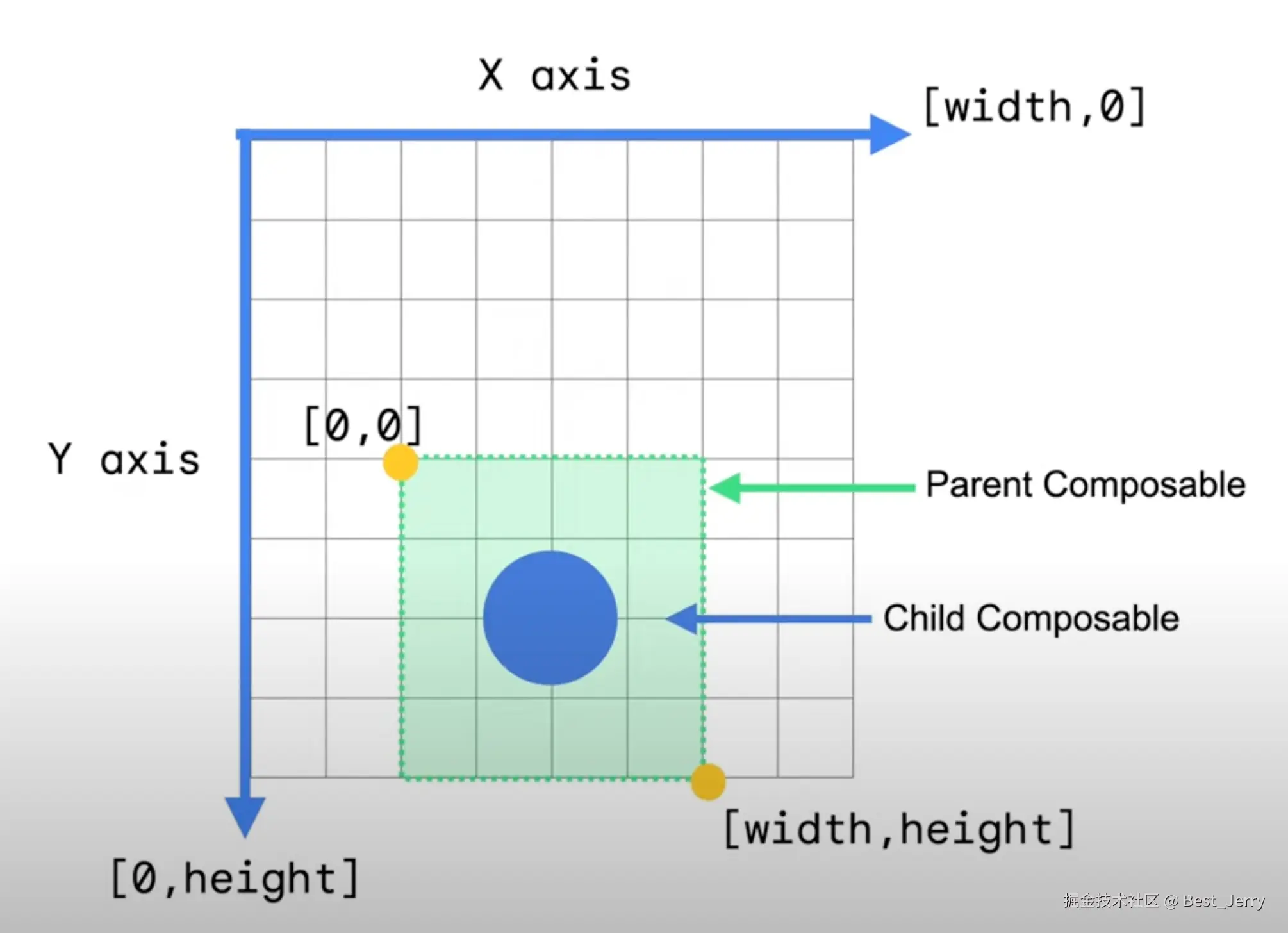
修改中心点的坐标: 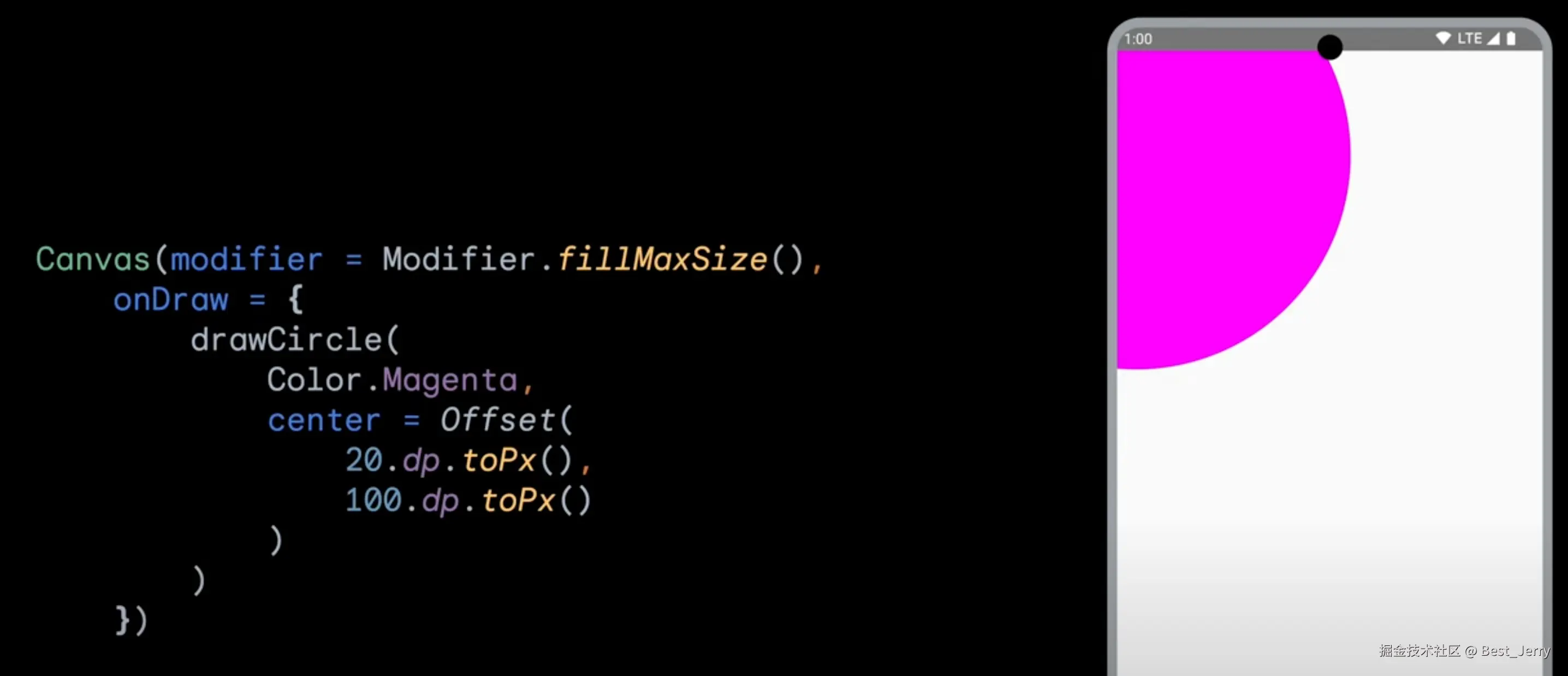
修改圆的半径: 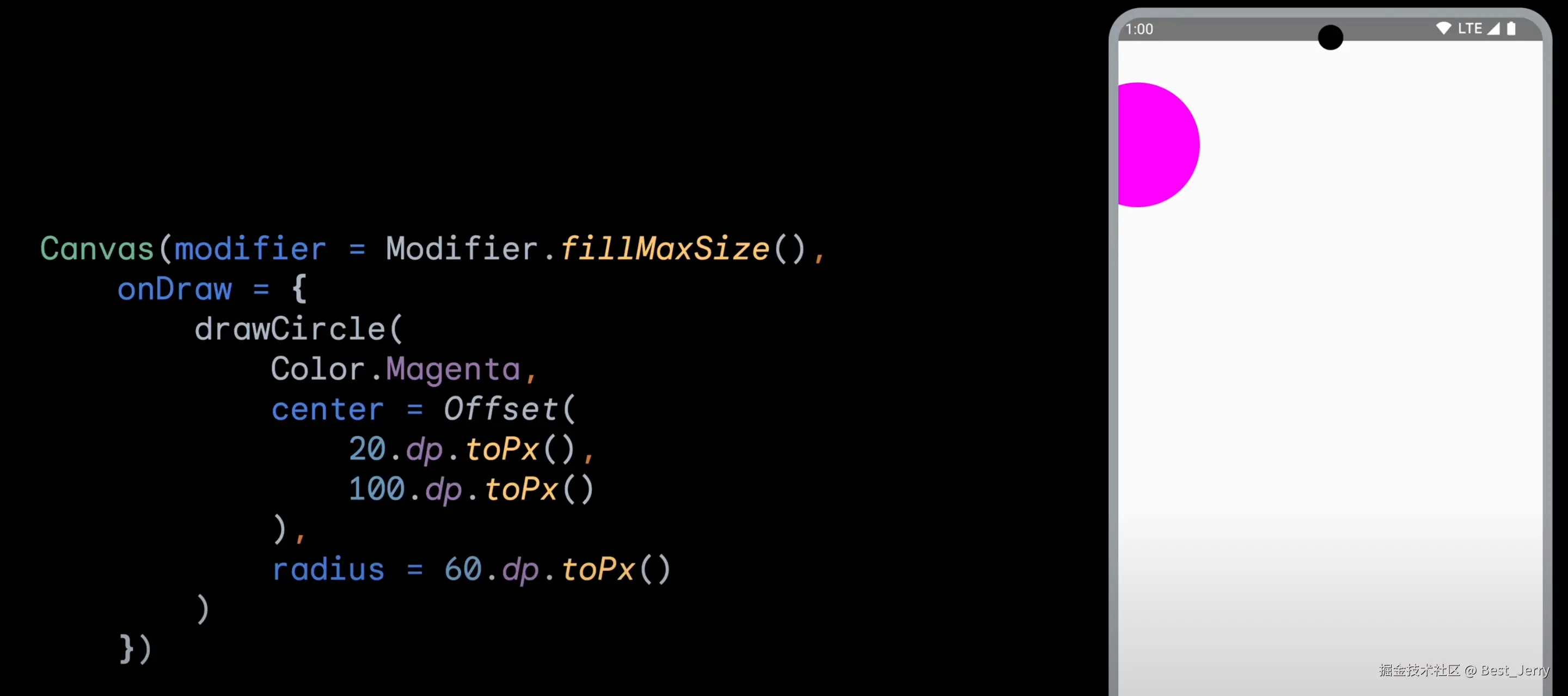
6. DrawScope Transformations
scale
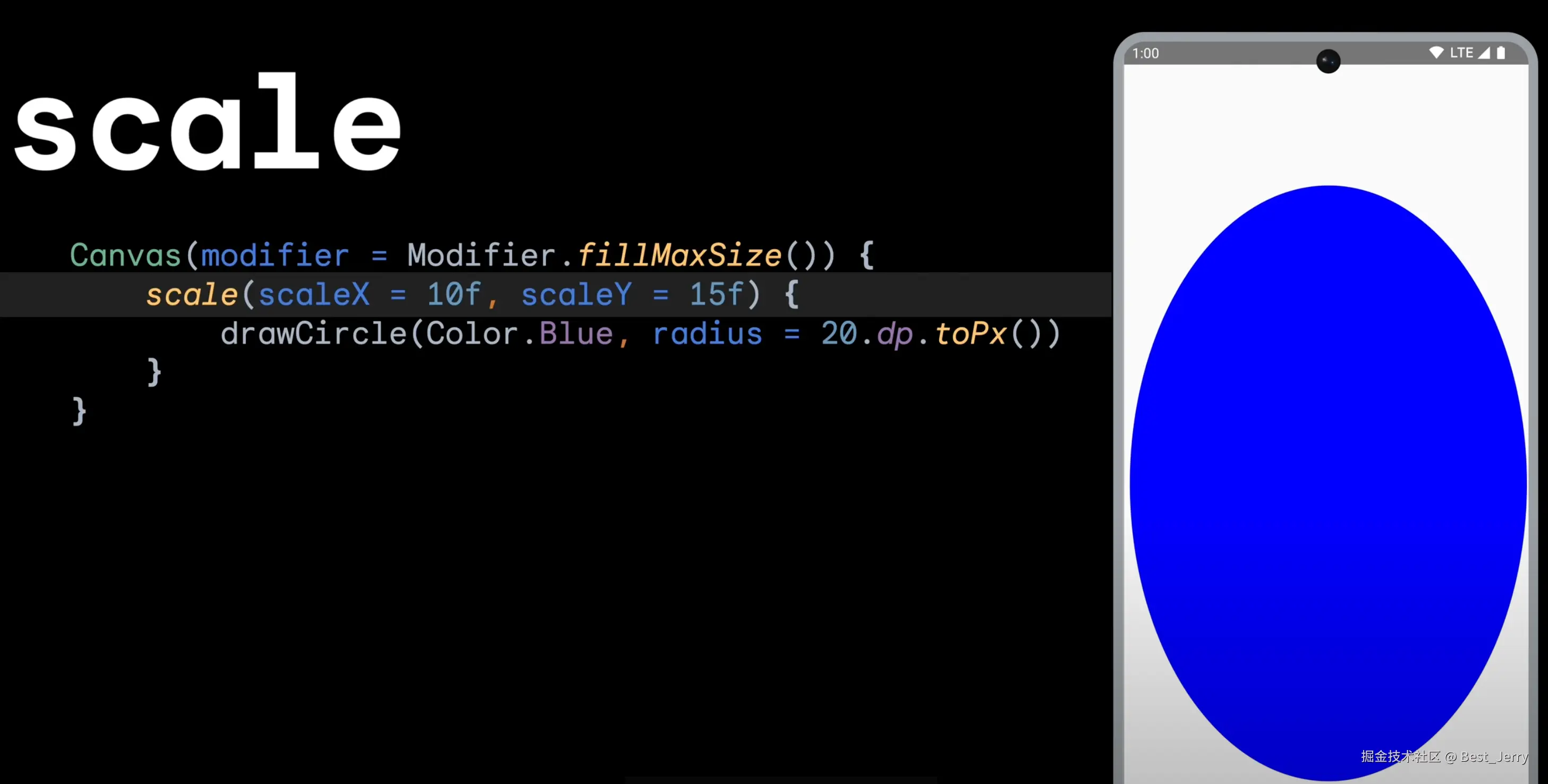
kotlin
inline fun DrawScope.scale(
scaleX: Float,
scaleY: Float,
pivot: Offset = center,
block: DrawScope.() -> Unit
) = withTransform({ scale(scaleX, scaleY, pivot) }, block)translate
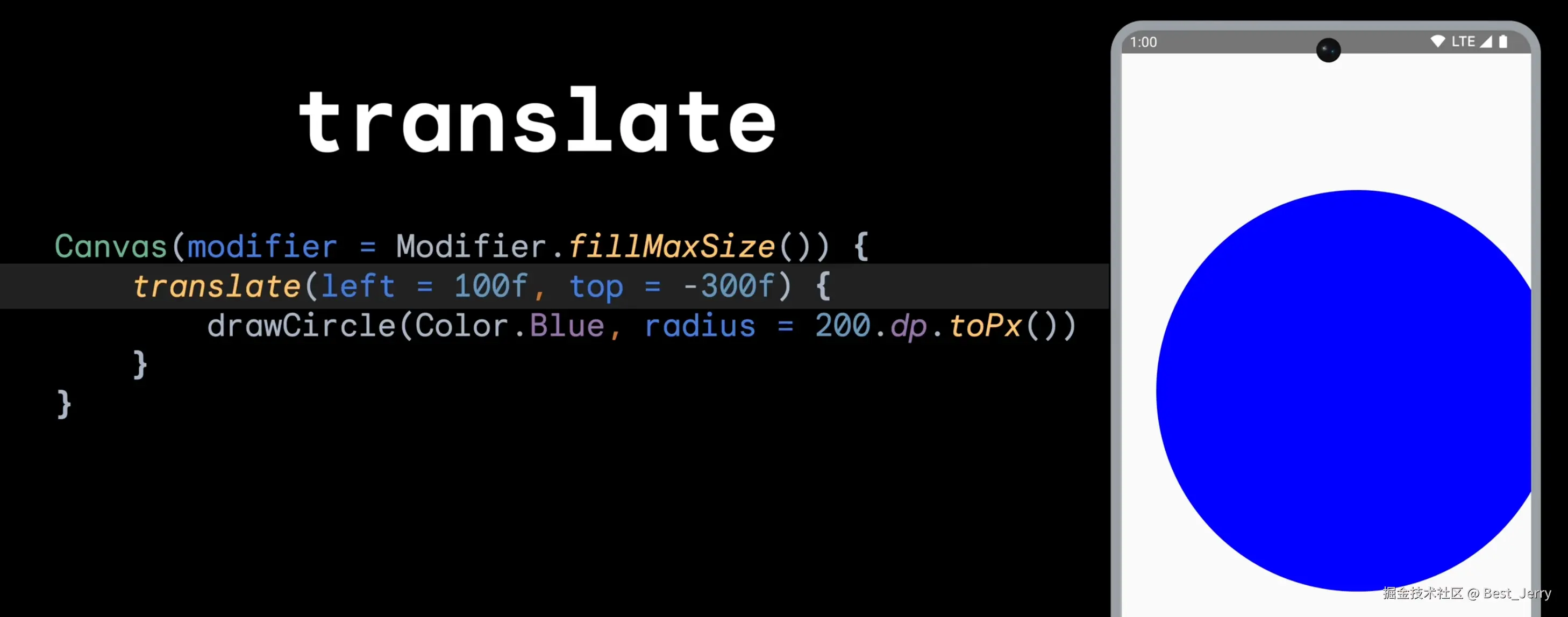
kotlin
inline fun DrawScope.translate(
left: Float = 0.0f,
top: Float = 0.0f,
block: DrawScope.() -> Unit
) {
drawContext.transform.translate(left, top)
try {
block()
} finally {
drawContext.transform.translate(-left, -top)
}
}rotate
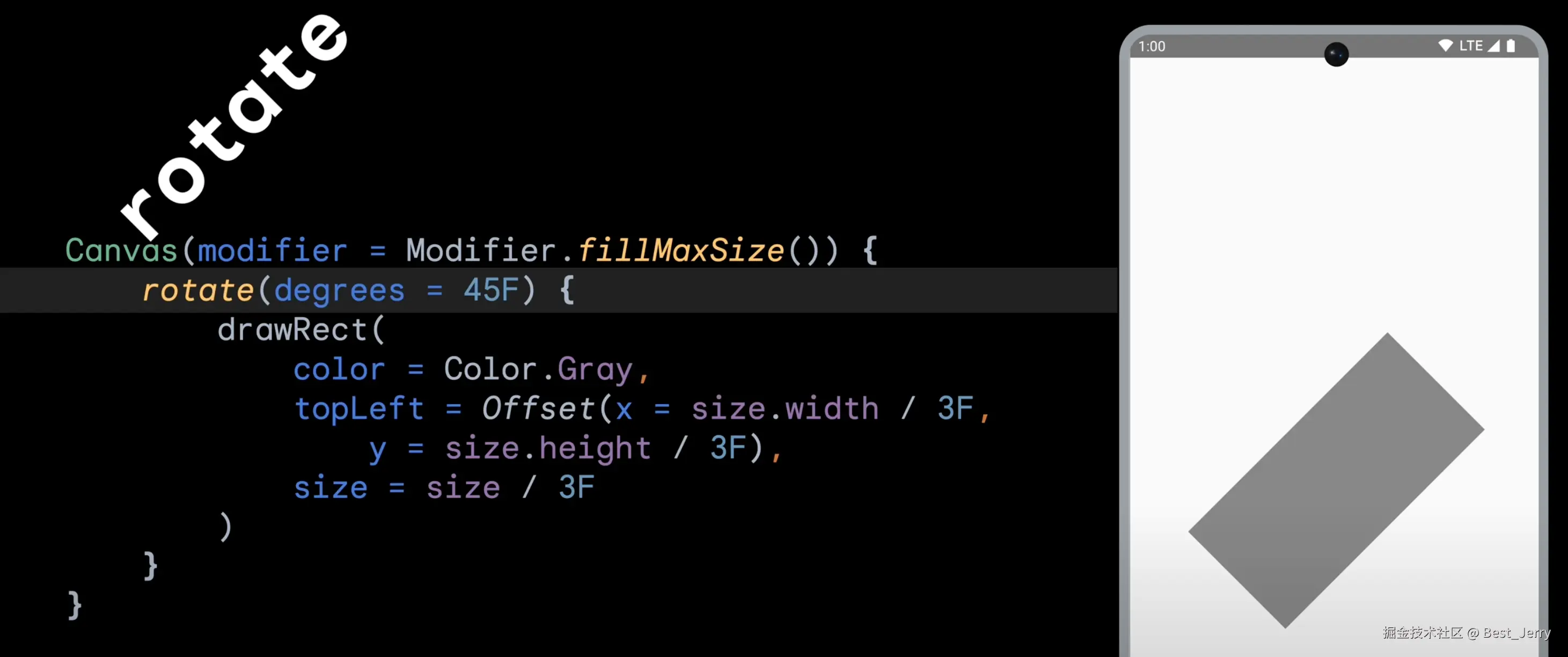
kotlin
inline fun DrawScope.rotate(
degrees: Float,
pivot: Offset = center,
block: DrawScope.() -> Unit
) = withTransform({ rotate(degrees, pivot) }, block)inset
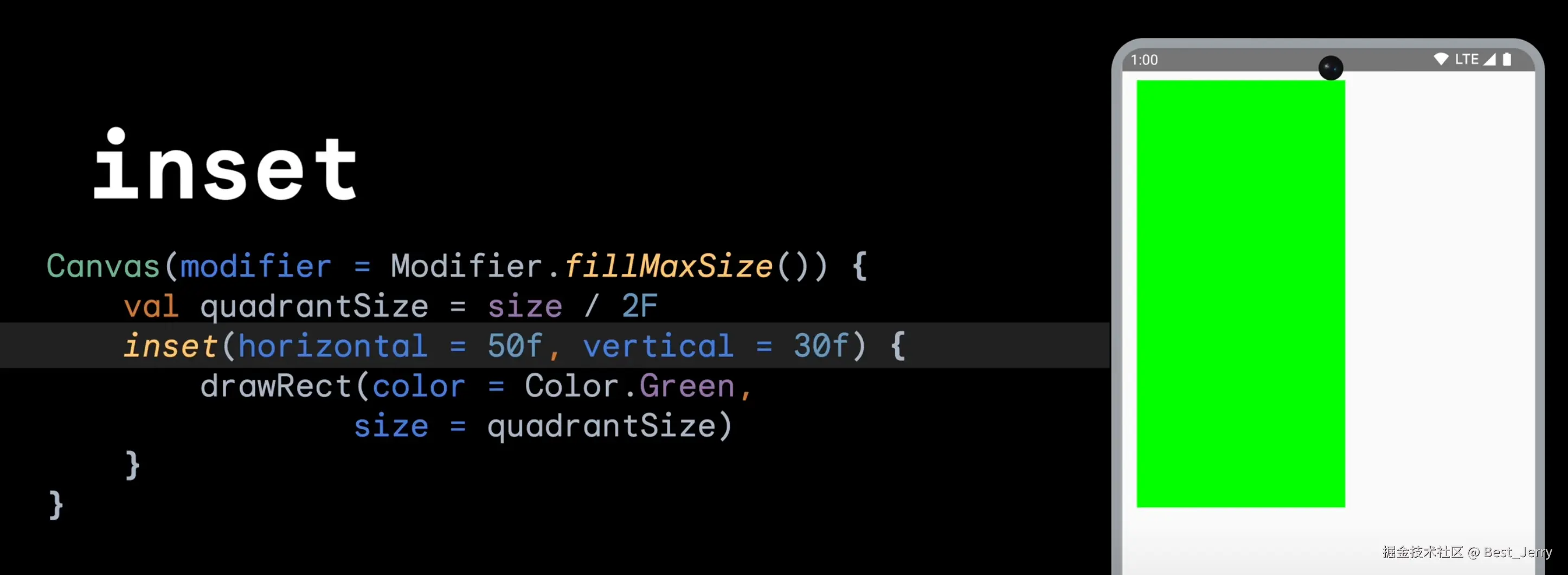
kotlin
inline fun DrawScope.inset(
left: Float,
top: Float,
right: Float,
bottom: Float,
block: DrawScope.() -> Unit
) {
drawContext.transform.inset(left, top, right, bottom)
try {
block()
} finally {
drawContext.transform.inset(-left, -top, -right, -bottom)
}
}Multiple transformations
使用 withTransform
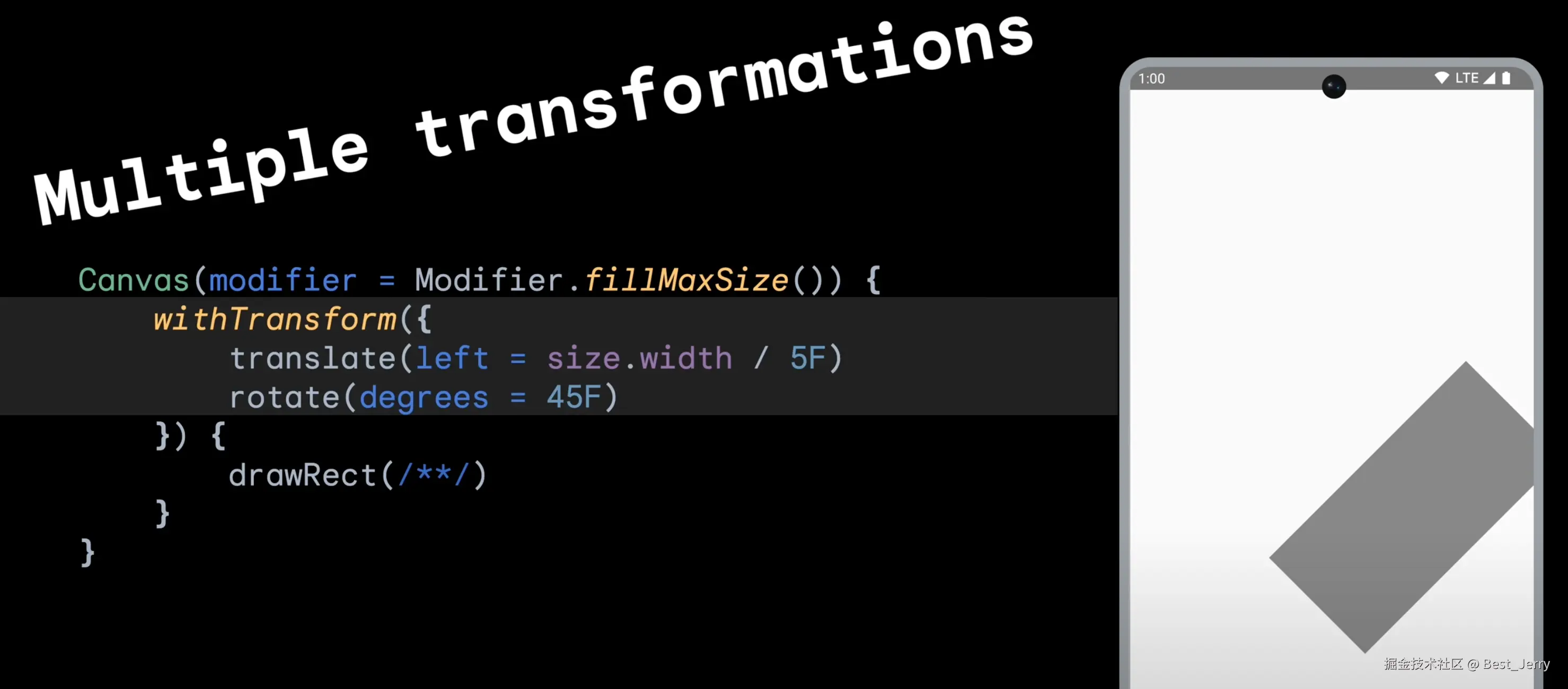
kotlin
inline fun DrawScope.withTransform(
transformBlock: DrawTransform.() -> Unit,
drawBlock: DrawScope.() -> Unit
) = with(drawContext) {
// Transformation can include inset calls which change the drawing area
// so cache the previous size before the transformation is done
// and reset it afterwards
val previousSize = size
canvas.save()
try {
transformBlock(transform)
drawBlock()
} finally {
canvas.restore()
size = previousSize
}
}7. Example - Line Graph
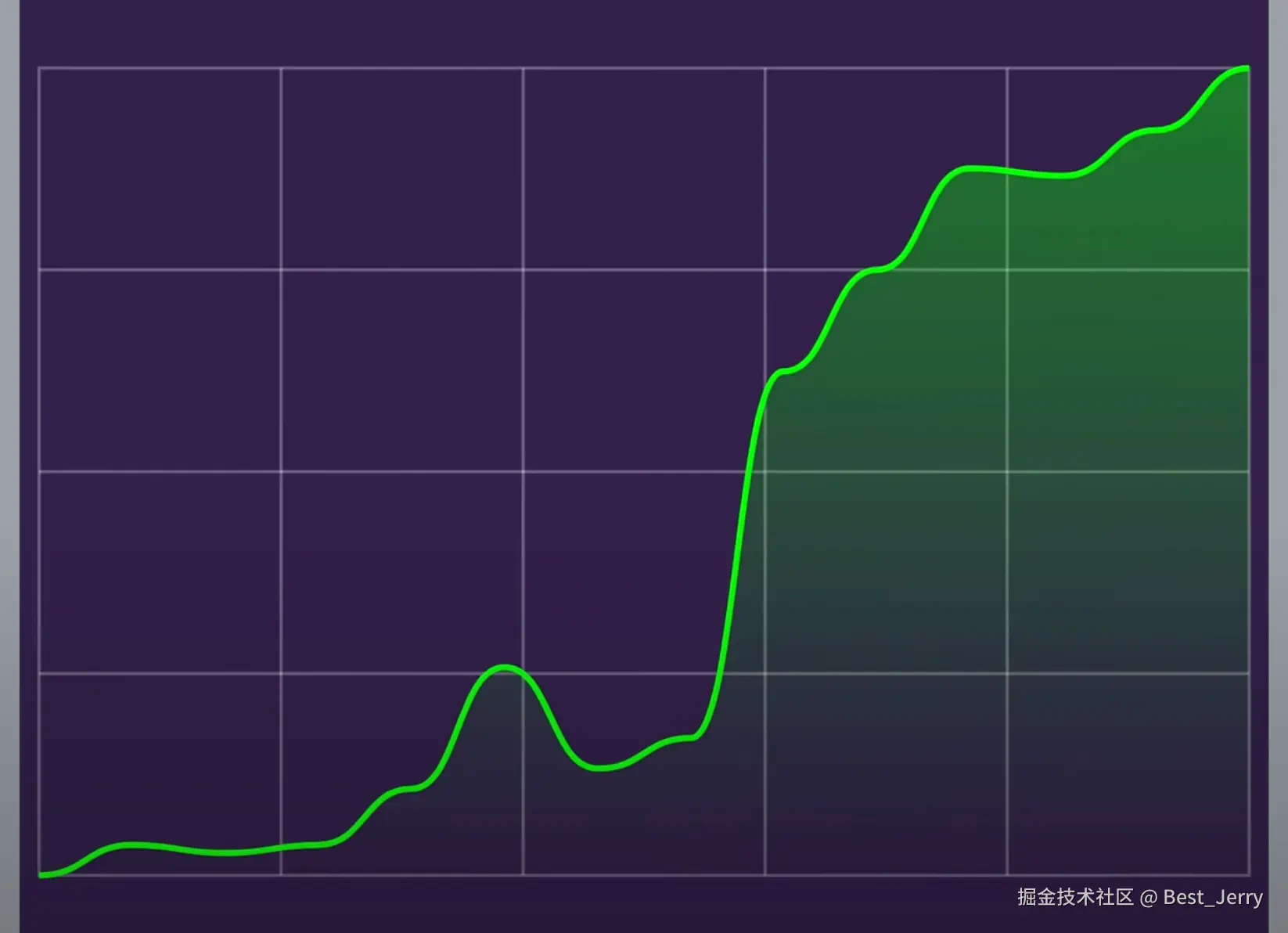
8. drawLine background
首先绘制背景
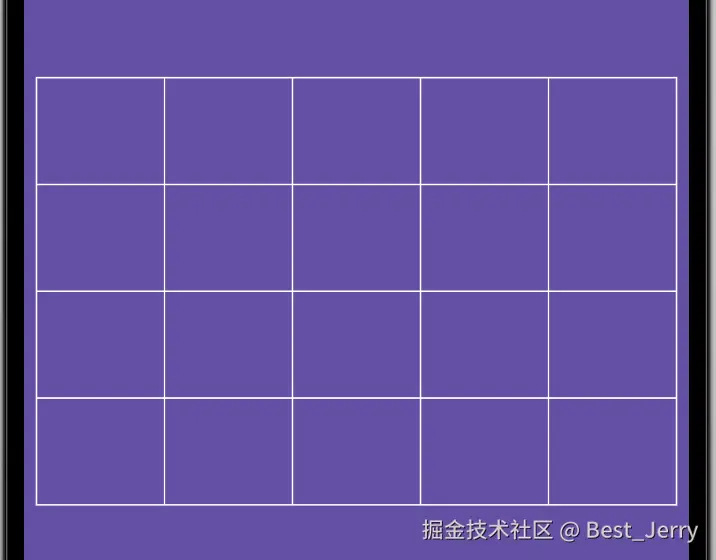
kotlin
@Composable
fun LineGraph() {
Box(
modifier = Modifier
.background(Purple40)
.fillMaxSize()
) {
Canvas(
modifier = Modifier
.padding(8.dp)
.aspectRatio(3 / 2f)
.fillMaxSize()
.align(Alignment.Center)
) {
val barWidthPx = 1.dp.toPx()
drawRect(Color.White, style = Stroke(barWidthPx))
val verticalLines = 4
val verticalSize = size.width / (verticalLines + 1)
repeat(verticalLines) { i ->
val startX = verticalSize * (i + 1)
drawLine(
Color.White,
start = Offset(startX, 0f),
end = Offset(startX, size.height),
strokeWidth = barWidthPx
)
}
val horizontalLines = 3
val sectionSize = size.height / (horizontalLines + 1)
repeat(horizontalLines) { i ->
val startY = sectionSize * (i + 1)
drawLine(
Color.White,
start = Offset(0f, startY),
end = Offset(size.width, startY),
strokeWidth = barWidthPx
)
}
}
}
}9. drawPath
绘制代表数据的实际线条。
我们不想在每次重新组合时都重新创建这个路径对象。为了避免这种情况,我们可以切换到使用 drawWithCache 修饰符,它将负责缓存对象,直到绘图区域的大小发生变化。
创建路径数据:
kotlin
data class Balance(
val x: Int,
val y: Int
)
val graphData = mutableListOf<Balance>(
Balance(0, 0),
Balance(1, 45),
Balance(2, 34),
Balance(3, 9),
Balance(4, 21),
Balance(5, 36),
Balance(6, 4),
Balance(7, 4),
Balance(8, 54),
Balance(9, 87),
Balance(10, 81),
Balance(11, 51),
Balance(12, 95),
Balance(13, 52),
Balance(14, 42),
Balance(15, 93),
Balance(16, 8),
Balance(17, 11),
Balance(18, 63),
Balance(19, 52),
Balance(20, 7),
Balance(21, 12),
Balance(22, 90),
Balance(23, 74),
Balance(24, 8),
Balance(25, 99),
Balance(26, 75),
Balance(27, 92),
Balance(28, 61),
Balance(29, 11),
Balance(30, 21),
Balance(31, 60),
Balance(32, 74),
Balance(33, 89),
Balance(34, 74),
Balance(35, 82),
Balance(36, 23),
Balance(37, 8),
Balance(38, 47),
Balance(39, 18),
Balance(40, 4),
Balance(41, 55),
Balance(42, 54),
Balance(43, 61),
Balance(44, 34),
Balance(45, 23),
Balance(46, 47),
Balance(47, 64),
Balance(48, 66),
Balance(49, 35),
Balance(50, 8),
Balance(51, 15),
Balance(52, 89),
Balance(53, 13),
Balance(54, 24),
Balance(55, 53),
Balance(56, 57),
Balance(57, 23),
Balance(58, 86),
Balance(59, 68),
Balance(60, 80),
Balance(61, 60),
Balance(62, 90),
Balance(63, 54),
Balance(64, 41),
Balance(65, 40),
Balance(66, 62),
Balance(67, 24),
Balance(68, 32),
Balance(69, 30),
Balance(70, 91),
Balance(71, 83),
Balance(72, 84),
Balance(73, 91),
Balance(74, 23),
Balance(75, 48),
Balance(76, 32),
Balance(77, 13),
Balance(78, 74),
Balance(79, 16),
Balance(80, 37),
Balance(81, 3),
Balance(82, 4),
Balance(83, 8),
Balance(84, 16),
Balance(85, 82),
Balance(86, 5),
Balance(87, 34),
Balance(88, 61),
Balance(89, 84),
Balance(90, 13),
Balance(91, 38),
Balance(92, 32),
Balance(93, 54),
Balance(94, 35),
Balance(95, 78),
Balance(96, 58),
Balance(97, 50),
Balance(98, 31),
Balance(99, 9),
Balance(100, 71)
)
fun generatePath(data: List<Balance>, size: Size): Path {
val path = Path()
data.forEachIndexed { i, balance ->
// 处理路径起始点不从 (0,0) 开始
if (i == 0) {
path.moveTo(0f, size.height)
}
val x = (balance.x / 100f) * size.width
val y = size.height - ((balance.y / 100f) * size.height)
// 将途经点添加到路径中
path.lineTo(x, y)
}
return path
}
kotlin
Spacer(
modifier = Modifier
.padding(8.dp)
.aspectRatio(3 / 2f)
.fillMaxSize()
.align(Alignment.Center)
.drawWithCache({
val path = generatePath(graphData, size)
onDrawBehind {
drawPath(path, Color.Green, style = Stroke(2.dp.toPx()))
}
})
)10. Filling graph area
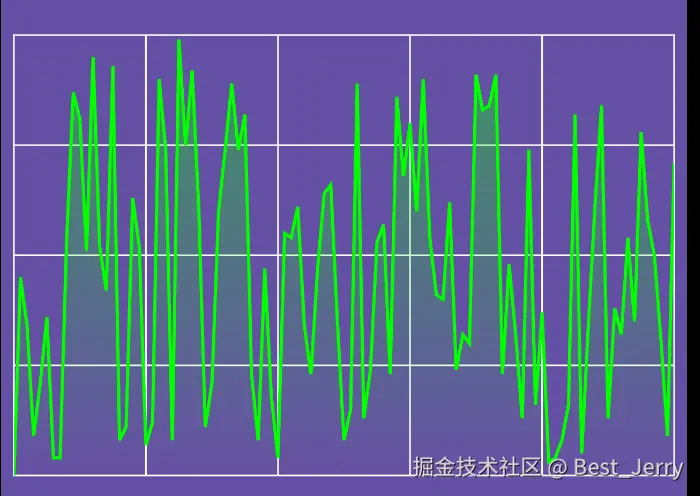
kotlin
Spacer(
modifier = Modifier
.padding(8.dp)
.aspectRatio(3 / 2f)
.fillMaxSize()
.align(Alignment.Center)
.drawWithCache({
val path = generatePath(graphData, size)
val filledPath = Path()
filledPath.addPath(path)
// 封闭右侧
filledPath.lineTo(size.width, size.height)
// 封闭底部
filledPath.lineTo(0f, size.height)
// 关闭路径
filledPath.close()
onDrawBehind {
// 创建渐变刷子
val brush = Brush.verticalGradient(
listOf(
Color.Green.copy(alpha = 0.4f),
Color.Transparent
)
)
// 绘制线条路径
drawPath(path, Color.Green, style = Stroke(2.dp.toPx()))
// 绘制渐变区域
drawPath(filledPath, brush = brush, style = Fill)
}
})
)11. Smoothing path lines
使路径线条变得平滑。
修改 generatePath() 方法,生成带有曲线的路径。
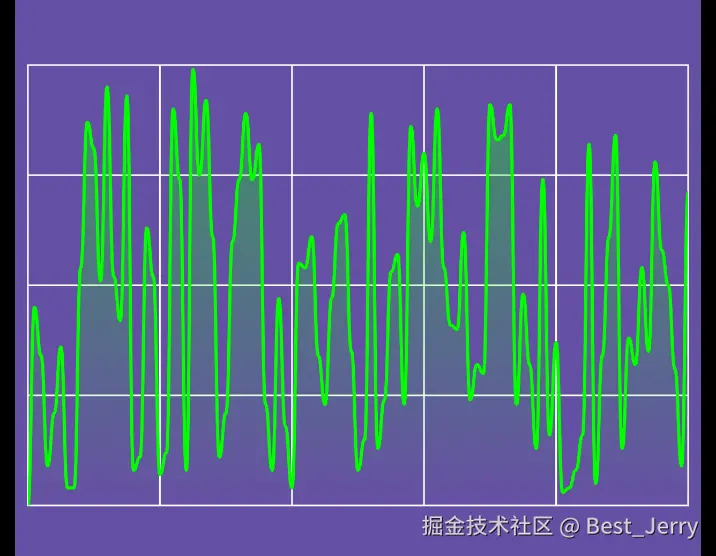
kotlin
fun generateSmoothPath(data: List<Balance>, size: Size): Path {
val path = Path()
var previousBalanceX = 0f
var previousBalanceY = size.height
data.forEachIndexed { i, balance ->
if (i == 0) {
path.moveTo(0f, size.height)
}
val x = (balance.x / 100f) * size.width
val y = size.height - ((balance.y / 100f) * size.height)
val controlPoint1 = PointF((x + previousBalanceX) / 2f, previousBalanceY)
val controlPoint2 = PointF((x + previousBalanceX) / 2f, y)
path.cubicTo(controlPoint1.x, controlPoint1.y, controlPoint2.x, controlPoint2.y, x, y)
previousBalanceX = x
previousBalanceY = y
}
return path
}12. Animate graph drawing
启动图表时为绘制线条添加动画。
创建动画值并启动:
kotlin
val animationProgress = remember { Animatable(0f) }
LaunchedEffect(key1 = graphData) {
animationProgress.animateTo(1f, tween(3000))
}使用 clipRect 剪辑绘制:
kotlin
clipRect(right = size.width * animationProgress.value) {
val brush = Brush.verticalGradient(
listOf(
Color.Green.copy(alpha = 0.4f),
Color.Transparent
)
)
drawPath(path, Color.Green, style = Stroke(2.dp.toPx()))
drawPath(filledPath, brush = brush, style = Fill)
}clipRect 源码实现:
kotlin
inline fun DrawScope.clipRect(
left: Float = 0.0f,
top: Float = 0.0f,
right: Float = size.width,
bottom: Float = size.height,
clipOp: ClipOp = ClipOp.Intersect,
block: DrawScope.() -> Unit
) = withTransform({ clipRect(left, top, right, bottom, clipOp) }, block)